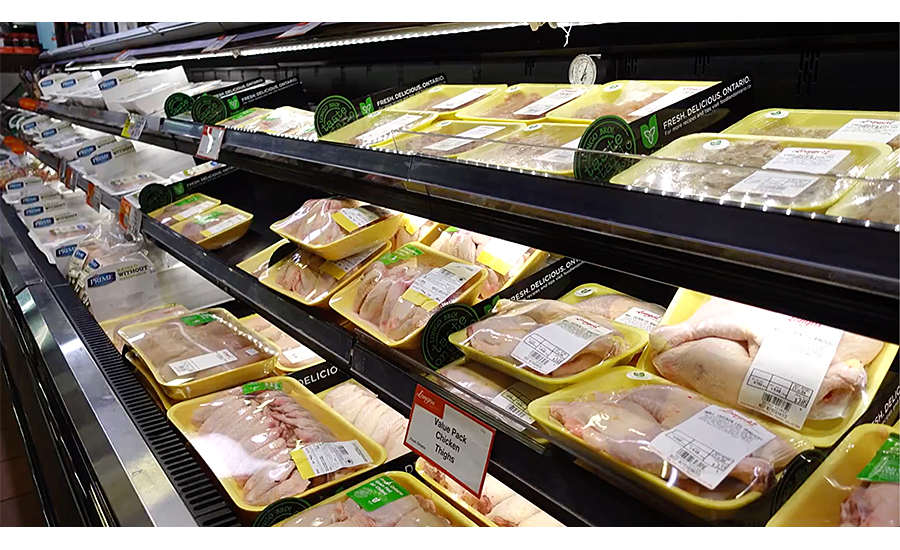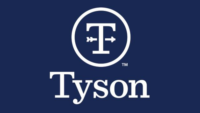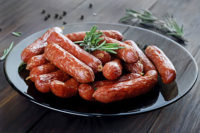Case-ready packaging carries a heavy load. It’s tasked with representing the product and its values, protecting food safety, preventing color discoloration and prolonging shelf life. And refinements to packaging technology only continue to evolve.
“Our labels are used to tell a story and invite a dialogue with our consumers,” says Michael Forrest, CEO Americas at Thomas Foods International, USA, in Swedesboro, N.J. “Labels are a great billboard to tell our personal brand story, our rich history of family farms and pasture-raised lamb, beef and veal, as well as our unique features and benefits.”
Packaging — whether it’s on modified-atmosphere packaging trays, chub packages or brick packages — is one of the first aspects consumers will notice about the product.
“With today’s technology, we can continue to interact with our consumers via the label to further nurture the relationship with a call to action for our website where we share recipes, how-to videos and garner product feedback,” Forrest says.
This information is critical for shoppers looking for products that meet their values. “The target audience for our product is a consumer who prefers claims like natural or no added hormones,” says Nick Lahm, production manager at Certified Piedmontese Beef, in Lincoln, Neb. “We use graphic labels to communicate our benefits and distinguish us from other programs. On our value-added items, we are able to tell a short story about our product that includes differentiators such as breed characteristics and how the cattle were raised.”
Creating the perfect package
Packaging certainly educates consumers about the product within, but consumers can also benefit from learning more about the packaging itself. In recent years, much progress has been made with case-ready materials that utilize modified-atmosphere packaging (MAP). While this packaging prolongs shelf life and prevents color discoloration, it can also appear to do the opposite to uneducated shoppers, sometimes emitting a gassy smell when opened and briefly imparting a brown color to ground beef.
MAP allows companies to better control the environment their case-ready meat or poultry resides in before purchase, while another common tool — vacuum packaging — works by removing all gases.
With MAP, a mix of gases including carbon monoxide are injected into the case-ready package to create an optimal atmosphere: maintain product color, control humidity, slow decomposition and prevent microbial growth.
“MAP is a great technology, but manufacturers also have to first put a quality product in the package, too,” says Edward Mills, Ph.D., associate professor of meat science at Pennsylvania State University, in University Park. “It has to be kept cold and not have microbial organisms, rather than just slowing their growth.” Today, manufacturers are refining the gas mix inside the package, Mills says. Master packs or bags further assist with MAP technology. They are used to hold individually wrapped, non-barrier trays; then as much oxygen as possible is flushed out of the bag (to delay oxidation); carbon dioxide and nitrogen are added; and lastly oxygen scavengers are included to keep oxygen out of the sealed packages. Retailers can then open the packs as needed to restock the meat and poultry case. As long as the master pack is kept refrigerated and closed, the individually wrapped products’ shelf life should be good for 30 days.
“From a consumer point of view, master packs are a big step forward, because the product and film both look good,” says Mills.
Modifying consumer expectations
Because poultry isn’t as sensitive to color changes as meat, it’s able to use a variety of packaging systems, says Mills, such as MAP, controlled-atmosphere packaging and active and intelligent packaging.
“The challenge with individually wrapped trays is to get the gas mix just right — and keep it right,” says Mills. “They are more sensitive to variations in gas composition.”
All systems are sensitive, however, to any degree of gas leakage. “MAP provides a greater opportunity to put oxygen scavengers in the master pack” to prevent color changes (or browning) caused by oxidation, Mills says.
As manufacturers increasingly move to MAP systems, consumers will have to learn to trust the sell-by dates on packaging rather than just its appearance. “With MAP, product color is not an indication of freshness,” Mills says. NP
For more information about case-ready packaging, visit the folling suppliers:
Apex Packaging Solutions www.apexpkg.com
Bunzl Processor Division/KochSupplies www.bunzlpdpackaging.com
Flair Flexible Packaging Corp. www.flairpackaging.com
Harpak-ULMA Packaging LLC www.harpak-ulma.com
Middleby Food Processing and Packaging www.middprocessing.com
Multivac Inc. www.multivac.com
Novipax LLC www.novipax.com
Ossid www.ossid.com
Progressive Packaging Inc. www.progressivepackaging.com
Reiser www.reiser.com
ultrasource www.ultrasourceusa.com





Report Abusive Comment